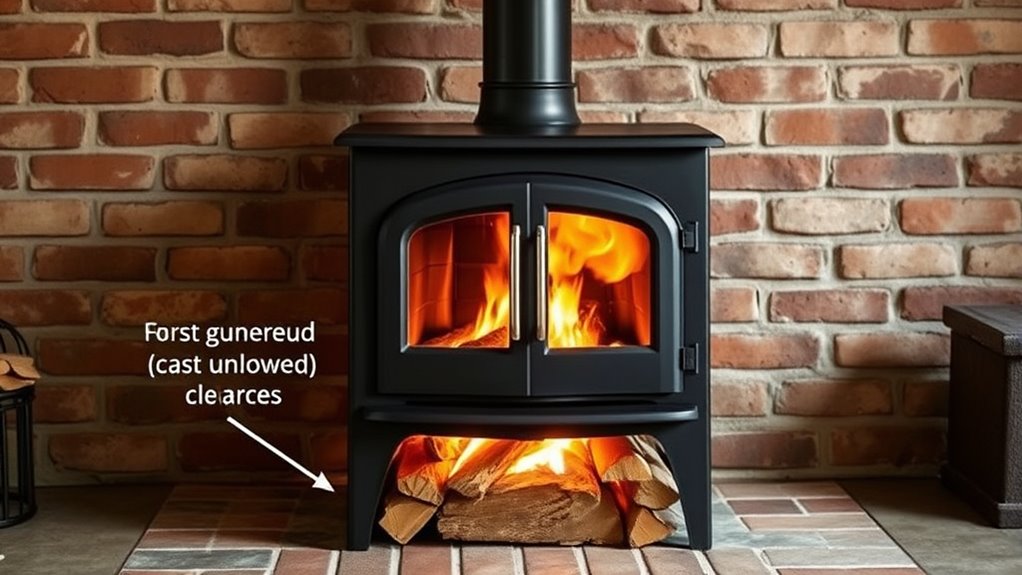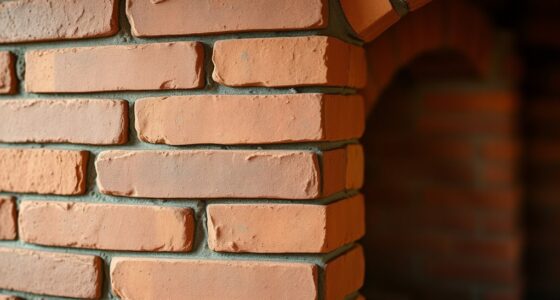To guarantee safe installation of your wood stove, maintain at least 18 inches of clearance in front and a few inches on the sides, following manufacturer guidelines. Build your hearth with fire-resistant materials like brick or stone, extending out in front and to the sides to contain heat. Proper ventilation is vital to prevent harmful fumes, and using heat-resistant materials helps protect your home. Keep these basics in mind and you’ll learn how to create a safe, efficient setup.
Key Takeaways
- Maintain at least 18 inches of clearance in front of the stove for safety and proper airflow.
- Use fire-resistant materials like brick or stone to construct a level hearth that extends beyond the stove’s sides and front.
- Ensure proper ventilation with ducts drawing fresh air from outside and venting gases safely outside the home.
- Follow manufacturer instructions and local building codes for clearances, hearth size, and material requirements.
- Use fireproof materials around the stove area to contain heat, prevent fires, and ensure long-term safety.

Ensuring proper clearances and understanding hearth basics are essential steps when installing a wood stove. You want to make sure that your setup is safe, efficient, and compliant with local building codes. One of the key aspects to consider is ventilation requirements. Proper airflow is crucial to prevent the buildup of dangerous fumes like carbon monoxide and to ensure your stove operates efficiently. You need to install adequate ventilation ducts or vents that draw in fresh air from outside and exhaust smoke and gases safely outside your home. Ignoring ventilation requirements can lead to poor air quality indoors and pose serious health risks, so double-check the specifications for your stove model and adhere to local regulations. Additionally, the choice of fire-resistant materials plays a vital role in safeguarding your home. When constructing your hearth and surrounding areas, use fire-resistant materials such as brick, stone, or specially designed fireproof boards. These materials help contain heat and prevent accidental fires from combustible materials getting too close to the stove. The hearth must extend far enough in front and to the sides of the stove to act as a protective barrier. This clearance distance varies depending on the stove’s size and manufacturer guidelines, but generally, you should allow at least 18 inches in front of the stove and a few inches on each side. Ensuring these clearances are met not only keeps your setup safe but also helps the stove operate properly, preventing overheating and damage. When it comes to hearth construction, don’t skimp on quality; a well-built hearth made from fire-resistant materials provides a sturdy, heat-resistant platform that can withstand high temperatures without cracking or deteriorating over time. You should also consider the height of the hearth, making sure it’s level and at the right elevation to facilitate safe loading and cleaning. Remember, your goal is to create a safe environment where heat is contained and the risk of fire is minimized. Proper clearances, ventilation, and materials all work together to achieve this. It’s worth investing time and effort to understand these basics thoroughly before proceeding with your installation. Consulting manufacturer instructions and local building codes can give you peace of mind, ensuring your wood stove setup meets all safety standards. Taking these precautions seriously helps protect your home, your loved ones, and your investment, making your heating solution both effective and safe for years to come. Additionally, understanding camping safety principles can help you prepare for outdoor fire safety during colder months when using your stove in an outdoor shelter or camping scenario.
Frequently Asked Questions
Can I Install a Wood Stove on a Wooden Floor?
Yes, you can install a wood stove on a wooden floor if you follow proper fireplace safety and stove installation guidelines. You need to place a non-combustible hearth pad underneath the stove that extends beyond its edges, ensuring adequate clearance and protection. Always check local building codes and manufacturer instructions to ensure safe installation, and consider consulting a professional to verify all safety measures are met for a secure and efficient setup.
Are There Specific Clearance Requirements for Different Stove Models?
Yes, different stove models have specific clearance requirements for safe operation. You should always check the stove’s manufacturer instructions for the recommended stove clearance to prevent fire hazards. When doing a hearth installation, make sure it meets or exceeds these clearance guidelines to protect walls, furniture, and flooring. Proper clearance helps ensure safe heat distribution and minimizes the risk of heat damage or accidental fires.
How Often Should I Inspect My Hearth for Damage?
You should examine your hearth for damage at least once a year, especially before the heating season begins. During the inspection, look for signs of fire damage, cracks, or other deterioration that could pose a safety risk. If you notice any issues, address them promptly to prevent potential hazards. Regular inspections help ensure your hearth remains safe, functional, and compliant with safety standards.
What Types of Non-Combustible Materials Are Best for Hearths?
You should choose fire-resistant tiles or refractory bricks for your hearth, as they withstand high temperatures and resist damage. Picture a sturdy, polished surface or rugged bricks that protect your floor from sparks and heat. These non-combustible materials offer durability and safety, contrasting with flammable surfaces. By selecting the right materials, you guarantee your hearth remains safe, functional, and visually appealing for years to come.
Is It Safe to Use a Wood Stove With a Carpet Underneath?
You shouldn’t place a wood stove directly on a carpet because it’s a fire hazard. Instead, you can use fire-resistant carpets or hearth protective mats designed for stove safety. These materials help prevent heat transfer and protect your floor from sparks or embers. Always make certain the mat extends the recommended distance from the stove and consult local safety codes to keep your home safe while enjoying your wood stove.
Conclusion
By understanding clearances and hearth basics, you’re building a safe, warm haven out of your home. Think of your wood stove as the heart of your space—centered and essential—while proper clearances act as its shield. When you follow these guidelines, you’re not just preventing hazards; you’re creating a cozy sanctuary that’s as safe as it is inviting. With knowledge in hand, you can enjoy the warmth without worry, turning your home into a comforting retreat.









